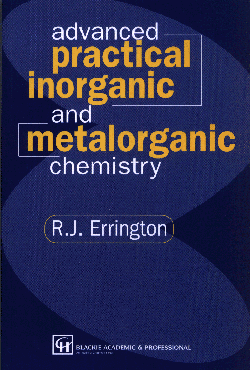Home
page

|
Advanced
Practical Inorganic and Metalorganic Chemistry
Blackie Academic and Professional,
London, 1997
ISBN 0 7514 0225 7
Currently available from
Stanley
Thornes publishers
This is the first new book for over
ten years to cover all aspects of preparative
inorganic/metalorganic chemistry involving air-sensitive
compounds. It is intended to be a bench-top handbook for
postgraduates, who will find it useful throughout their
research careers, and final-year undergraduates involved
in inorganic research projects, who need information
about techniques not covered in standard laboratory
courses. This text is already being used by the author as
the basis for a postgraduate course on advanced
preparative techniques, and is ideally suited for use
with multimedia resources.
|
KEY
FEATURES
• Techniques used most widely by
preparative inorganic/metalorganic research groups to handle
air-sensitive materials are described in detail.
• A chapter on special techniques
includes descriptions of important new preparative
methods.
• A survey of synthetic routes to an
extensive selection of starting materials is included.
• Extensive safety information is
provided.
• Readily affordable.
CONTENTS
Purpose:
This book is intended as a handbook for
preparative chemists working with air-sensitive compounds. Although
primarily for new research workers in inorganic/metalorganic
chemistry, others with some training in practical chemistry who wish
to acquire the skills necessary for handling air-sensitive materials
will find it a useful source of information and advice.
Scope:
All aspects of laboratory work with air-sensitive
compounds are covered, with an emphasis on safety. From setting up
the laboratory bench and associated equipment, the reader is guided
through various procedures for carrying out reactions, separating
products and preparing samples for analysis. Schlenk and dry-box
techniques are described in detail, as are high-vacuum manipulations
of volatile reagents and solvent purification. The essential features
of several more specialised techniques are also described, and
references to leading articles are provided for further reading. A
survey of preparative routes to an extensive selection of important
starting materials includes associated literature references and
brief descriptions of the procedures involved.
Appealing
features:
The book is written in a very readable style and
is extensively illustrated. The price is readily affordable by
research students. All those involved in synthetic
inorganic/metalorganic chemistry will find the survey of preparative
methods useful.
